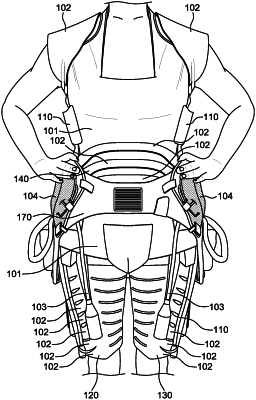| CPC B25J 9/0006 (2013.01) [A61H 1/02 (2013.01); A61H 1/0266 (2013.01); A61H 3/00 (2013.01); A63B 21/0004 (2013.01); A63B 21/00181 (2013.01); A63B 21/4007 (2015.10); A63B 21/4011 (2015.10); A63B 21/4039 (2015.10); A63B 21/4043 (2015.10); A63B 24/0087 (2013.01); A61H 2201/123 (2013.01); A61H 2201/1642 (2013.01); A61H 2201/1647 (2013.01); A61H 2201/165 (2013.01); A63B 2209/00 (2013.01); A63B 2209/10 (2013.01); A63B 2220/51 (2013.01); A63B 2220/803 (2013.01); A63B 2225/096 (2013.01); A63B 2225/50 (2013.01); A63B 2230/605 (2013.01); G05B 2219/40305 (2013.01)] | 12 Claims |

|
1. A method for assisting human movement using an exosuit comprising a plurality of sensors, a plurality of load distributing members, and a plurality of flexible linear actuators (FLAs) that are coupled to and operative to apply forces between the plurality of load distributing members such that the exosuit provides assistance in spinal extensor, hip extensor, and hip flexor muscle movements, the method comprising:
monitoring the plurality of sensors to determine which one of a plurality of assistive movements a user of the exosuit desires to execute; and
executing the assistive movement determined to be desired by the user based on the monitoring, wherein said executing comprises:
using a combination of any one or more of FLAs responsible for hip flexor assistance movement (the hip flexor FLAs), FLAs responsible for hip extensor assistance movement (the hip extensor FLAs), and FLAs responsible for spinal extensor assistance movement (the spinal extensor FLAs); and
applying a force and time threshold scheme to the combination of FLAs being used to execute the assistive movement determined to be desired by the user based on the monitoring;
wherein an assistive movement of the plurality of assistive movements is a sit-to-stand assistive movement;
detecting, via at least one of the plurality of sensors, that the torso is leaning forward; and
initiating execution of the sit-to-stand assistive movement in response to the detecting that the torso is leaning forward, wherein executing the sit-to-stand assistive movement comprises:
activating the hip flexor FLAs to initiate a lean forward movement of a torso of a body, wherein the hip flexor FLAs increase force tension until a hip flexor force reaches a hip flexor holding force threshold;
maintaining the hip flexor force at the hip flexor holding force threshold for a first period of time;
activating the hip extensor FLAs prior to an end of the first time period to initiate a lift movement of the body, wherein hip extensor FLAs increase force tension until a hip extensor force reaches a hip extensor holding force threshold;
activating the spinal extensor FLAs to assist in the lift movement of the body, wherein the spinal extensor FLAs increase force tension until a spinal extensor force reaches a spinal extensor holding force threshold; and
deactivating the hip flexor FLAs at the end of the first period time such that hip flexor FLAs decrease force tension to further assist in the lift movement of the body.
|